Last year at this time, Vanity Fair and Elle tried a shocking experiment: they published green-themed issues. Could mainstream readers handle eco-news if it came in the shape of Julia Roberts and Evangeline Lilly (and, uh, Chip Giller)? Would green really prove to be the new black ink?
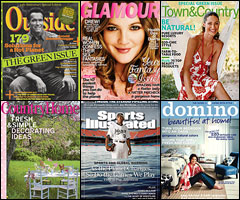
Covering green issues … or just
green-issue covers?
They could, and it would. After the success of last year’s spring surge, a new crop of magazines is getting on board with the idea of going green — if only for one issue. Glamour has just published a 10-page spread with eco-tips and an in-depth online guide. Perhaps more surprising: a recent cover story on climate change in Sports Illustrated. “We’ve reached critical mass,” says SI Senior Editor Richard Demak. “It’s time to address this in all venues — why shouldn’t sports be one of them?”
Four more glossies — Country Home, Outside, Town & Country, and domino — have put out green issues for April, and Elle is planning a reprise in May. “For the longest time, glossy magazines kind of stayed away from the green concept because they were a little scared of it,” says Tom Farley, senior editor at Town & Country. “They thought that to go green meant that people had to wear hemp clothing or live off the grid in a yurt somewhere. As the movement has evolved, the choices have evolved too.”
So how are the glossies evolving? Here’s a rundown of their eco-efforts.
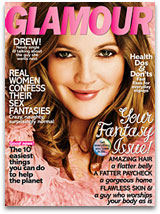
Glamour
Why they did it: In her editor’s note, Editor in Chief Cindi Leive confesses she’s not a born environmentalist, but says she’s realized that small changes make a difference. If every Glamour reader swapped just one incandescent light bulb with a compact fluorescent, she says, the benefit would be like taking 87,500 cars off the road for a year.
How they did it: The focus of the 10-page spread is on clothing and beauty supplies — big surprise for a beauty magazine! But green makes its way onto other pages as well, in the form of profiles of dreamboat Robert F. Kennedy Jr. and Arctic activist Sheila Watt-Cloutier.
Does it work?: The package seems to hit on many of the important issues that would affect Glamour‘s mostly female audience: safe cosmetics, green garments, and healthy foods. Too bad the mag didn’t follow in Elle‘s footsteps and realize that any woman worth her weight in lipstick and bangles would welcome an entire green issue.
Our hopes for their audience (circ. 2,250,000): Glamazons everywhere will put down their mascara long enough to find the real beauty in being green.
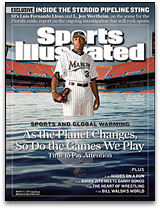
Sports Illustrated
Why they did it: The SI editors decided it was high time sports fans realize that global warming is a formidable rival for any team.
How they did it: The mid-March cover feature “Going, Going, Green” includes a map showing stadiums in the San Francisco Bay Area and Florida that would be affected (read: underwater) after a rise in sea level. The mag also put together a feature on the eco-friendly Cooks Creek Golf Club, a projected count of ski days lost to global warming, and a creative envisioning of sports arenas of the future, complete with public transit as well as sun and wind power.
Does it work?: The map is highly effective; the only fans who’d want to see their stadium underwater are those cheering on swimmers and water polo players. The editors really brought the issue home for their specialized audience.
Our hopes for their audience (circ. 3,150,000): Nine out of 10 SI readers will buy recycled jock straps.

Outside
Why they did it: “In many ways, every issue of Outside is a green issue,” says editorial green-team leader Elizabeth Hightower in the issue’s opening note. “We’ve passionately covered the environment since we got started in 1977.” Hightower waxes poetic about the current sex appeal of the green movement. But it’s also the mag’s 30th anniversary, and there’s just something about leaving your 20s that makes you take a long, hard look at life.
How they did it: The issue includes short features on everything eco, from electric cars to future fabrics. “Green Giants” profiles 23 “real-world” sustainability leaders, including familiar faces like Ah-nold and Summer Rayne, as well as newcomers like an alternative-energy enthusiast turning algae into fuel. There are also major pieces on China and troubled waterways.
Does it work?: This one is green through and through — they’ve even donated $1 of each newsstand copy sale to Conservation Alliance. Especially enjoyable is the eight-page spread on a certain green humor website.
Our hopes for their audience (circ. 650,000): Campers, hikers, and kayakers around the world will climb every mountain to proclaim the green gospel.
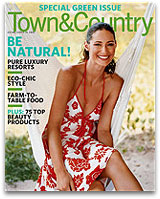
Town & Country
Why they did it: “We felt we could make a big difference,” says editor Farley, “because a lot of times, it’s the people who are upper-income who have the opportunity to vote with their pocketbooks and help make some of these products more generally available. [Our readers] want to do the right thing, but they maybe just don’t know the way to go about it.”
How they did it: The major stories in this themed issue, the first such venture by T&C, include a look at a (very fancy) Manhattan home built and furnished sustainably, a piece on a Nicaraguan eco-resort, and profiles of four eco-rageous women including Frances Beinecke of NRDC and furniture designer Paulette Cole. A special green tips section features notes on everything from cosmetics to organics.
Does it work?: Though Editor Pamela Fiori says she found it difficult to get everything in the issue to reflect the green theme, T&C staffers seem to have been successful. The only trouble is that all the green features are surrounded by ads exulting the consumption-heavy lifestyle this publication normally endorses.
Our hopes for their audience (circ. 450,000): Town & Country‘s readers will realize Town is where it’s at and start a wave of urban reintegration.

Country Home
Why they did it: “We are seeing a real interest by readers in exploring eco-friendly choices,” said head editor Carol Sheehan in a recent press release. “We wanted to find out who in America is actually taking action, where they are, and what they are doing.”
How they did it: In addition to incorporating elements of nature into almost every shot of a home interior, the issue also profiles a group of organic farmers in Boulder, Colo., and tours the country cottage of green guru Danny Seo, a style editor-at-large for the magazine.
Does it work?: Some of the deco-ideas are quite inspired (like reusing sweaters as dining-room chair covers), but covering a dresser in green wallpaper doesn’t make it green. And the Best Green Places Report is a disappointment, with just a handful of lists and not much background.
Our hopes for their audience (circ. 1,250,000): The cottage-dwelling set will use the issue’s resources to go for that eco-shabby look, and — dare we say it — they’ll reconsider that second home.
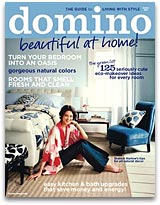
domino
Why they did it: Stylish design mag domino wanted to celebrate “those working to close up the cycle of production so that little is wasted and little harmed,” says Editor in Chief Deborah Needleman in her editor’s note.
How they did it: The centerpiece of the issue is the 2007 Green List, a partnership with Treehugger that showcases 125 companies and people with “undeniable eco-cred” and “irresistible style.” But the team didn’t stop there — they greened the whole issue, from a piece on pretty VOC-free paints to a two-page spread on the perfect organic antipasto, complete with shopping list.
Does it work?: The image-heavy pages offer helpful visuals of the cosmetics, home goods, and foodstuffs being profiled. Somehow, they even manage to make a water-saving urinal look über-hip.
Our hopes for their audience (circ. 550,000): Design-savvy readers will tear out the cheat sheets and tap into their own creativity to make green more fab than ever — and send old habits falling like a row of you-know-what.

